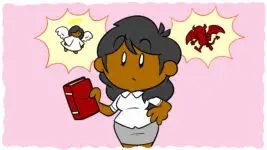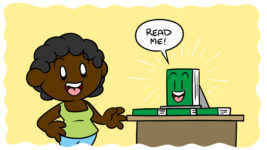An elevator pitch is a quick, punchy set of statements that you can use to sell your book to a publisher, agent, or reader. The idea is that, if the person you’re trying to sell to got into an elevator with you, you’d be able to deliver your pitch before they reached their destination.
Of course, that’s pretty unlikely, and the real idea is to use artificial pressure to identify the key selling points of your work. You may or may not use your elevator pitch directly, but it’s also a great starting point for query letters, meetings, book blurbs, and everything else you’ll have to write or say about your book (it also makes you look better at dinner parties). Not only that, but other people have to sell your book – agents to publishers, publishers to retailers, retailers to readers – and a good elevator pitch makes it easier for them to see how they’ll do so, and thus more willing to consider your work. Needless to say, it’s well worth your time to nail this skill.
What’s in an elevator pitch?
If you search around for elevator pitch advice, you’ll get a few mixed messages. Some people will give you a hard limit of 50 words, some will say a few hundred, and some will talk in pages.
This is because ‘elevator pitch’ isn’t a concrete term, so different sources are offering their interpretations. To avoid being another voice in the confusion, let’s define what we’re looking for from an elevator pitch.
Our elevator pitch needs to:
- Be immediately interesting,
- Provide all relevant information,
- Feel professional,
- Open the door to further discussion.
The final point more or less takes care of itself – the context of your pitch says that you want to talk further: no agent or publisher thinks you’re just writing because you thought they’d want to know. Later, I’ll touch on some ways to prompt further discussion in the event that you’re pitching directly, but the lion’s share of this will be automatic.
An elevator pitch is quick, effective, and economic with detail.Click To TweetFeeling professional, likewise, is somewhat in the phrasing, but mostly about nailing the first two goals. If you’re immediately interesting and tell the reader what they need to know (and you can avoid any unnecessary cursing), you’re making a professional pitch. Awesome: you only have to nail two goals.
‘Relevant information’ is, unfortunately, the hardest part of an elevator pitch to get right. What’s relevant to agents and publishers is very different to what you think is most important about a story, and it can take a lot of suppressing your authorial ego and striving for objectivity to get there. Still, it’s worth the effort, and there are fixed standards you can work by.
Finally, being immediately interesting is a little in the writing and a lot in prioritizing information. There, again, we’ve got you covered.
Structuring your pitch
Structuring your pitch does two things. First, it allows you to prioritize information. Second, it makes your pitch modular – if you create it with structured sections, you can remove or swap out those sections as your needs dictate.
So, what do we want to include in our pitch? Well, your needs may vary, but here are the elements to consider:
- Audience/Genre,
- Logline,
- Prior work,
- Comparisons,
- Synopsis.
Of these, audience and logline are the ‘must’s, since they’re the barest version of the pitch, but let’s take a look at each element individually.
Audience/Genre
This may be the hardest part of writing your pitch, since it’s the information about which authors find it hardest to be objective. You are, of course, free to use whatever approach you like, but if you want to write a successful elevator pitch, you’re going to have to banish the following two phrases, if only for a little while:
‘It doesn’t really have a genre.’
‘It’s for everyone, really.’
Art is complex and subjective, so these statements are often true, but they’re of absolutely no use to anyone down the line. Readers want to know if it’s in their area of interest, retailers need to give them that information, publishers need to communicate it clearly to retailers, and agents need to pitch it to publishers. The two phrases above, when involved in a pitch, say ‘I’m not going to help you sell this’, which is the exact opposite of what you’re trying to do.
Authors resist defining their audience, but that’s a turn-off for publishers.Click To TweetThe good news is that, to an extent, genre and audience are different approaches to the same question. While people from every imaginable demographic love literature from every conceivable genre, those genres have (or are at the very least seen to have) a core demographic. That core demographic tells everyone in the publishing chain how to market, sell, and stock your book.
Genre-wise, you can usually find the closest match if you interrogate your work. If you’re really stuck, it’s fine to mix two genres – a ‘fantasy mystery’, for example – and terms like ‘speculative fiction’ are acceptable if you feel your book would be genuinely mis-sold as ‘sci-fi’. If you really hate the genre approach, lean into that, and imagine your description of genre not as any kind of summary, but just an instruction about which section of the shop it’ll be shelved in.
Publishers look at genre as an indication of audience – it may be that they’re looking for a sci-fi book, since they don’t have one on their slate, or that they’re backing away from certain genres because they don’t want to be their own competition. Either way, it’s to your benefit to give the most accurate version of this information possible. If in doubt, take a look at some similar works and see how they describe themselves.
In terms of audience, age is a good place to start. If you’re writing for younger readers, it’s essential you pitch this right – age groups are basically different genres, here, in that publishers are trying to fill specific gaps. Other than that, are you writing for a group with a particular outlook? Is your political thriller for people outraged by the current system or for people generally interested in politics? Again, this is about who you’re selling to, so ‘fans of _____’ can often be useful information. A million YA elevator pitches invoke the The Hunger Games audience, and while that’s become so ubiquitous that it’s more or less a dry well, it’s the type of thing that tells a publisher you have a place in the contemporary market. I’ll return to this shortly in the context of when and where citing other works can be useful.
Logline
A logline is a (very) short synopsis of your story – we’re talking one sentence, two at most. This sentence is going to take a lot of work, paring down your initial description into its most compelling, informative form.
You’d be surprised the type of information that gets cut to form a good logline. Your antagonist, the bulk of your setting, and maybe even your most interesting characters might fall by the wayside in the name of a great elevator pitch.
The logline needs to say who the story is about, the goal they’re seeking, and the conflict they encounter. The setting may also feature, but this can take a lot of forms, and usually only comes to prominence if it’s somewhere (or somewhen) unusual. ‘A Texas lawyer’, for example, includes the setting in the character description.
In ‘Writing a Killer Logline’, Graeme Shimmin argues that ‘problem’ and ‘conflict’ are separate, positing both as part of his ‘Killogator logline formula’. The example he uses is a logline for Tinker, Tailor, Soldier, Spy, which goes:
The British Secret Service asks a retired spymaster to find a soviet mole who must be one of his former protégés. He can trust no one as he tries to discover who the traitor is.
Here, Shimmin argues that ‘to find a soviet mole’ is the problem and ‘he can trust no one’ is the conflict, with ‘to discover who the traitor is’ as the goal. I don’t think this is great advice for how to consider your own story – most of the time problem and conflict are so inseparable that trying to pry them apart will just have you chasing in circles – but Shimmin uses them as different ways to present the story, which may be useful in some pitches, and his formula is otherwise a good starting point for what you absolutely need.
A good logline only shares the essentials.Click To TweetAs an example of what you don’t, consider that Gandalf – arguably the most recognisable and iconic character from The Lord of the Rings – probably doesn’t belong in a decent elevator pitch (at least for the first book in the trilogy). As a first draft, that might go something like:
An unlikely fellowship sets out across an increasingly dangerous fantasy world to destroy an enchanted ring and prevent a war that would shroud their world in darkness.
You might focus more on Frodo, but Gandalf doesn’t tell anyone anything they need to know, and Sauron probably doesn’t need to be in your elevator pitch either, even though it’s his ring. Antagonists aren’t inextricable from the problems they cause, and sometimes those problems are more relevant than exactly who brought them about.
This varies: a decent logline for Kill Bill probably mentions the titular antagonist, since his death is the protagonist’s central goal, and you could argue that specifying that the fellowship is being actively pursued adds to the pitch, but the fact remains: you must mention the conflict, but antagonists are on a case-by-case basis. In the example above, ‘dangerous fantasy world’ is the conflict, though it could be more explicit. It’s something you’d punch up in a later draft, but it tells the reader the nature of the struggle in the story – the journey is perilous (and it clarifies the genre, too).
Do you need to include the resolution in your logline? In truth, it generally matters less than you might think. Character, conflict, and goal tend to accurately depict the reader’s journey through the book, with the ending providing context of varying value. Whether the mole is stopped in Tinker, Tailor, Soldier, Spy, the audience, genre, and other marketing information probably stays the same. Likewise, the eventual fate of the fellowship matters, it just doesn’t necessarily belong in your logline. Later, your publisher or agent may have thoughts on avoiding a downer or cliché ending, but for the elevator pitch, that’s not what they’re after.
The exception is when the ending changes or defines how the story would otherwise be understood. Twist endings, such as those in Fight Club or We Need to Talk About Kevin, should sometimes be folded into the logline, as should endings that define the piece, like that of Of Mice and Men. The reason for this is that they’re a major part of the reader’s journey, rather than just its end point. Where Tinker, Tailor, Soldier, Spy is about the hunt for a mole, Of Mice and Men isn’t about two men striving to escape the conditions of their lives, but rather their failure to do so. That the book is a tragedy is core to the reader’s journey, and that’s what the logline ultimately describes.
Prior work
It almost goes without saying that, if you’re pitching a project, you should mention any past successes. It’s a little reassurance that the agent/publisher/retailer/reader in question isn’t taking on a completely unknown quantity.
It’s not a must, of course, and you shouldn’t worry if you don’t have any prior work to cite – just don’t forget to mention it if you do.
Comparisons
Comparisons are a tricky tool, but one that can be useful in the right circumstances. Basically, this involves describing your work by saying what else it’s like. The risk is that your work comes off as unoriginal, but the reward is that it can give the listener an immediate and vibrant picture, and it can tie your project to a sense of success and marketability.
I mentioned young adult projects invoking The Hunger Games earlier, and it’s a comparison that has motivated million-dollar deals. The success of Suzanne Collins’ series underlined the money to be made with that particular audience, and so when authors or movie-makers pitch ‘the next Harry Potter’ or ‘the next Hunger Games’, they’re really saying ‘there’s a huge audience for this – it’ll sell’.
That’s a little direct, though, and less useful for author pitches. It can be more beneficial to describe your book using two or three others, especially if each covers a different aspect – one handles setting, one tone, for example – or they triangulate an important factor.
‘Twilight meets Pretty Little Liars’, for example, screams ‘we’re going to grab the teen demographic’. If, on the other hand, you were writing about a serial killer in the 1920s, you might say ‘Hannibal by way of The Great Gatsby’, linking an otherwise hard-to-picture setting with a saleable property. Another method is to use a single source with a spin: ‘Wuthering Heights in a cyberpunk future’.
Effective comparisons are proof your work will sell.Click To TweetIt’s imprecise, and reductive, and authors hate it, but it gives the pitchee an immediate image and suggests profitability. Use it sparingly, but keep it in mind – especially when discussing audience. ‘For those who enjoyed _____’.
This is really all you need for a basic elevator pitch – audience/genre and the tricks to make a logline sing. Of course, the intent of a pitch is to follow through, and there are many situations where you’ll also need…
Synopsis
A brief synopsis of one to two hundred words is a good follow-up to your logline – you can explore the story you’ve outlined in a little further detail and include even more details that describe your place in the market (this is the time to introduce Gandalf).
Writing a synopsis is hard, but it’s not as difficult as the paring down that goes into a logline, and we’ve got you covered there too, with How To Write An Amazing Synopsis.
Pitching in person
Pitching in person offers many unique opportunities, but chief among them is the ability to lead the discussion – this is where we return to opening the door to further discussion. If there are questions you want the listener to ask, that’s where you should draw your pitch to a close – ‘one of the book’s strongest attributes is its cast of fascinating, fully realized characters’ or ‘this project fulfils a unique niche within the existing market’. It’ll take an effort of will not to ask you to expand, which means you get to give a satisfying answer and steer the discussion.
Mastering the elevator pitch
Mastering the elevator pitch takes effort; the more willing you are to suppress your authorial ego and keep cutting, the more effective your pitch will become. Remember that here, as in most writing, brevity is your friend. You’re trying to express the most you can with as few words as possible; that’s the skill to practice.
Otherwise, your elevator pitch should be built around the market and what’s useful to the person you’re pitching to. As with all writing, your elevator pitch will improve the more you acknowledge that you’re producing something for someone else. What does the agent/publisher/retailer/reader need to know? The answer does change, so be sure to ask the question again with each reader/audience.
What’s the logline of your project, and what worries you about pitching? Let me know in the comments. Or, for more great advice on this subject, check out 5 Things You Need To Know Before Pitching Your Book and How To Write An Amazing Synopsis.






12 thoughts on “Mastering The Art Of The Elevator Pitch”
Hey, Rob. My recent project’s log line is “Aging-out of foster care forces an orphan to battle his asthenophobia and survive homelessness in the city alone.”
I have a few worries about pitching.
1) People don’t know what aging-out is.
2) People don’t know what asthenophobia is.
3) Could I explain these things quickly enough in an already fast elevator pitch?
4) Would these concepts intrigue the person or confuse/deter them?
Thanks in advance for any of your thoughts.
Hi Franco,
Thanks for commenting! Unique problems for a unique project:
1) I’m surprised this is the case, but if that’s what your beta readers are telling you, it’d be foolish to ignore them, especially if that’s who you’re pitching to (I’d assume a publisher would know, but best to be safe).
2) + 3) This is less surprising, and pretty difficult to explain. You could reference mental health, though it’s not exactly accurate, or else just mention an unusual phobia (‘unusual’ in terms of the general public, anyway). I’d suggest only elaborating if you can make everything else immediately understood.
4) Certainly asthenophobia is unfamiliar enough that it would intrigue the people interested in this type of story. Leaving foster care likewise, though I’m not sure the specific context of aging-out will do anything either way. Consequently, I’d suggest something along the lines of:
‘Forced out of foster care, an orphan battles his phobia of _________ to survive alone and homelessness in the city.’
or even
‘Forced out of foster care, an orphan battles asthenophobia to survive alone and homelessness in the city.’
Since, if everything else is clear, and with people understanding what ‘phobia’ means, the lack of immediate understanding might intrigue them more than anything. Either way, showing it to enough people to build up a consensus opinion should be a useful next step.
Best,
Rob
Thank you so much for your thoughts. I’ll try using different wording like “phobia of fainting”. And I’ll keep sharing different versions with more and more people for feedback. I always love your articles, and most articles on this website. I always learn so much here, and I truly appreciate the dialogue through posting. Thanks again. – Franco
My pleasure, and thanks for the kind words.
– Rob
Really great information and all! You really explained what is an elevator speech and how do use it. I found all of this very useful and thank you for it!
Hi Samuel,
My pleasure – thanks for the kind words.
Best,
Rob
Thanks, Rob, you have provided us with a roadmap to success at the endgame. Your instructions are comprehensive, yet succinct.
My pleasure, Jim. I’m really glad the article has been so well-received.
You guys ROCK! Thanks for this information. I am new to publishing but the things you post are right on target with the direction I am moving.
Thank you,
HMR
Hi Hector,
Thanks very much – I hope our articles keep being useful as your career develops.
Best,
Rob
Hello Mr. Wood,
I’m currently working on my elevator pitch and I have been researching various articles on the subject, including yours. My concern about elevator pitches is that it seems not to be an exact science. Pitches are different to many authors/writers who write about how to write elevator pitches.
I’m wondering, does the success of an elevator pitch depend also on the person you are pitch to? Should it be suggested that “reading” a potential literary agent’s or editor‘s behavior or knowing their likes and dislikes when pitching to them may have a factor in overall success?
Thank you,
M Colin Alston
Hi M,
Yes and no.
Yes: Reading the person in front of you, and tailoring how you approach them, is always going to be a valuable skill in any negotiation. As much as you’re able to do this well, you should, though beware the fact that this can complicate matters hugely – if I get the sense that you’re just telling me what I want to hear, or if you read me wrong and I can’t tell why you’re behaving strangely, that’s going to do a lot more damage than is justified by what you stood to gain from getting it right.
No: Here’s the thing we perhaps don’t talk about enough when it comes to authors pitching their work – every publisher, from the most mainstream to the most indie, has specific desires that are in constant flux. They’re not just looking for good books, they’re looking for good books that don’t conflict with anything on their existing slate or which work with the type of marketing they’re best at, or a hundred other qualifiers. The recipient of your elevator pitch is therefore, even more than being an individual, an individual trying to navigate a unique set of circumstances that you probably won’t be able to see and certainly can’t change. (This is why this gets played down in a lot of pitching advice – there’s nothing you can about it, so better to focus on the things you can control.)
There’s a lot of talk about how foolish the publishers who turned down J.K. Rowling must feel, but for a lot of them, that was probably the right decision at that time. If I know I’m just about to bring a new middle-grade fantasy story to the market, then it may be that I’d be a fool to take on another, since I’m breaking up the audience (two sets of fans making medium noise rather than one set providing a culture-defining roar), or splitting the budget I’ve been given to advertise middle-grade writing, or market analysis is telling me that it’s a risk, and I can’t afford two risks at once.
This is relevant to your point because even more than personal preference, it’s the X factor that’s going to influence a lot of your pitches. Publishing Exec A may not like a book, but they’re an expert in whether or not it’ll sell, so while you can put them off with a bad pitch, you’re not going to win them over if that core virtue isn’t there. On top of that, they’re obsessed with what THEY can sell, and that may run entirely counter to their own preferences.
My advice would be to do your market research – look at what this publisher has sold in the past, look at what they’re publishing right now, and present yourself favorably in that light, but don’t try and game the system. Publishing Exec B might love YA horror but have just come from a meeting where their boss said that they can’t take on anything that’s strict horror for the next year. In that case, you’ll get great vibes from them, but they’ll still turn you down. If your book is YA horror then that’s fine, that would’ve been a bad fit right now, but if it’s more YA action that you described as horror because that’s what it seemed like they liked, you lost out on something for no good reason, even though you’ll never know it.
So, present to the person in front of you, do your market research, but stay both truthful and succinct. They’re an expert in what they want, and the best thing you can do is give them the information to make that decision without offering any other distractions. I think part of the reason pitching advice varies so much is that we want to believe there’s a way for us to be in control of whether or not someone sees the value in our work. Overall, it’s possible to adopt a mindset where random execs aren’t the ultimate arbiters of your work’s value, but case by case, you’re pitching and they’re deciding, and outside of the data they’re looking for, it’s hard to deliberately say something in a way that seals the deal and easy to accidentally say something in a way that causes problems.
Best,
Rob